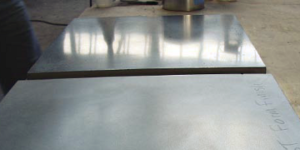
My dad, Dan Mattingly, started Mattingly Concrete in 1987 with little more than a truck and a few shovels. He was knocking on doors looking for work, literally, and even driving to and from the ready-mix supplier to put concrete in a bin in his truck and drive it himself to shovel it into the smaller jobs he would take on. In 2015, Mattingly Concrete is coming off of a record year, completing nearly $1.5 million in work from nearly 200 jobs over a 42-week season. We’re on pace to complete even more in the coming year. Here are some simple ways to efficiently grow your company from the ground up.
Growing your business on limited resources can seem daunting or nearly impossible, but it is achievable over time with hard work and a clear plan of action. Adding employees can be a tough idea to grasp, when considering additional payroll and human resources. It’s another animal to keep additional workers busy, happy and healthy along with office staff. But you’ll need them.
Step 1: Get your name out there and brand everything.
We use fliers more than anything but also rely on a solid website, social media, referrals, truck lettering, yard signs and print advertising. Aside from paid advertising or referrals, branding yourself is the best thing you can do for your business. If you ask people how they heard about you and they reply, “I’m not sure. I’ve just seen you around,” or “I see you guys everywhere,” then you’re doing it right.
Step 2: Reply quickly to every inquiry.
The faster you get to the estimate, the more likely you are to get the job. Most homeowners appreciate a prompt response and your chances of getting the job increase if you’re the first one to the site. Your prices matter but responsiveness is even more important.
Step 3: Find good people and retain them.
Good workers are hard to find, so when they have a problem, try to hash it out without firing them. You need to retain people that understand your company. As for workers that excel: reward, reward, reward! Make sure your best employees know you are the best employer.

Step 4: Take pride in your work and document your projects.
There’s no better way to sell future jobs than by showing potential clients pictures of what they will get. Documenting is also useful for remembering job details and scope and the final outcome.
Step 5: Be clear in your contract.
Adjust your contract as needed and clearly list work to be completed or omitted. Be transparent with the customer and protect yourself from unrealistic goals. Nine of 10 residential restoration-type jobs will have some form of demo or dirty process involved. Let the customer know what to expect. Be very clear. Irrigation and lighting are the two most common underground items that are not marked well and usually take a beating.
Also, needing to re-landscape in some areas is almost a guarantee. Use this language: “We are concrete craftsmen. The concrete will be beautiful but here is the potential collateral.”
Then we usually list a few trusted contractors that we like working with in those areas.
Customers appreciate the diligence and detail of this type of proposal. We get some jobs solely because we have the most detailed contracts. We have also lost work due to our warnings. Those clients did not want to face the “collateral” and probably hired a less-prepared contractor who agreed to cover those things.
Also, ask for a 50 percent deposit when you start the job. No sooner, no later. On larger jobs, 20 percent will suffice with common draws during construction. If your reputation and references are solid, most customers will not have a problem with this, but it’s a must. This will usually cover your materials plus some payroll and keep your company safe from the occasional disastrous client. It also allows the client a form of comfort knowing you still need to complete the job to collect the remainder. Win-win.
Step 6: Maintain your equipment and vehicles.
Don’t let dangerous items like ripped extension cords and faulty equipment go for long or at all. Stay on top of these issues and preach to your crews about doing the same. Offer compensation for not needing to replace tools as often and you will see a difference. Schedule daily meetings with your crew leaders to discuss safety issues. Keep your teams aware and informed through weekly meetings, and discuss a different safety item each time.
Step 7: Clean up!
When you leave a jobsite, try to make it look as if you were never there. Aside from obvious ruts in the yard and the expected items, clean everything each day you wrap up and certainly make sure the house and everything are secure. Just keeping someone’s mailbox clean creates a lot of goodwill. Save the headache and the callbacks and put someone in charge of cleaning up jobs or sealing them. This way, they will get good at it and know what to look for.
Step 8: Organize the office.
Hire an office person and train him or her. This person will be imperative to success by dealing with invoicing/finalizing/sending contracts, organizing work orders and purchasing stock for daily use. This person can also be in charge of employee time-keeping (electronic version suggested), job tracking and scheduling.
Once work gets going, the office person will keep your clients in the loop on progress. Maintain a 30-day calendar at all times. Whenever it rains or you have a delay simply push the schedule back one day and move on.
Step 9: Stockpile commonly used items. Everything should have its place around your shop/storage. Keep things organized and maintain a running tally of decorative products and regular items such as rebar, sealers, expansion material, even gravel. Everything should be rebilled to each job to track expenditures on each job.
Step 10: Be efficient!
Always keep efficiency in mind for every task at hand. Your labor adds up quickly and payroll is of upmost importance in a well-oiled company. Once you contract a job, take pictures of the existing site and staple them together with the original contract and any permits and info detailing everything you discussed with the homeowner or business owner. Put that in a binder for your manager to keep handy at all times.
If everything is working perfectly, you get the job, your office creates the work order, your guys pick the necessary items and equipment from your shop based on the work order (no high-cost individual trips to Lowe’s or Home Depot), and your manager takes his ready-for-action team to the job. No hiccups.
These 10 simple steps and processes can dramatically change the way your company gets things done. You can start profiting more without raising your prices based solely on organization and operations streamlining.
But take it slow. This won’t happen overnight. It took us 28 years to get here without any loans, by inching our way in the right direction. We are still trying to improve our systems with every passing moment. If you must take out loans, make them small and only for important items.
















